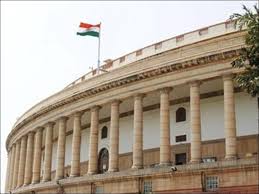
CANCELLATION OF THE WINTER SESSION
CONTEXT:
- The government has recently decided to cancel the Winter session of Parliament, citing fears over a surge in cases due to covid-19 pandemic.
SESSIONS OF PARLIAMENT:
- The summoning of Parliament is specified in Article 85 of the Constitution.
- The power to convene a session of Parliament rests with the Government.
- The decision is taken by the Cabinet Committee on Parliamentary Affairs which is formalised by the President, in whose name MPs are summoned to meet for a session.
- India does not have a fixed parliamentary calendar. By convention (i.e. not provided by the Constitution), Parliament meets for three sessions in a year.
- The longest, Budget Session (1st session), starts towards the end of January, and concludes by the end of April or first week of May. The session has a recess so that Parliamentary Committees can discuss the budgetary proposals.
- The second session is the three-week Monsoon Session, which usually begins in July and finishes in August.
- Winter Session (3rd session), is held from November to December.
SUMMONING OF PARLIAMENT:
- Summoning is the process of calling all members of the Parliament to meet.
- The President summons each House of the Parliament from time to time.
- The gap between two sessions of the Parliament cannot exceed 6 months, which means the Parliament meets at least two times in one year.
ADJOURNMENT:
- Adjournment terminates the sitting of the House which meets again at the time appointed for the next sitting.
- The postponement may be for a specified time such as hours, days or weeks. If the meeting is terminated without any definite time/ date fixed for the next meeting, it is called Adjournment sine die.
PROROGATION:
- Prorogation is the end of a session. A prorogation puts an end to a session. The time between the Prorogation and reassembly is called Recess.
- Prorogation is the end of session and not the dissolution of the house (in case of Lok Sabha, as Rajya Sabha does not dissolve).
QUORUM:
- Quorum refers to the minimum number of the members required to be present for conducting a meeting of the house.
- The Constitution has fixed one-tenth strength as quorum for both Lok Sabha and Rajya Sabha.
- Thus, to conduct a sitting of Lok Sabha, there should be at least 55 members present while to conduct a sitting of Rajya Sabha, there should be at least 25 members present.
